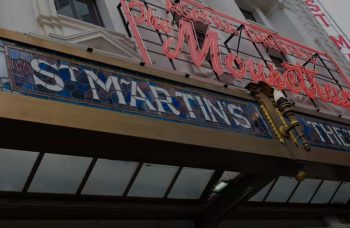Numerous independent theatre performers are using the current context of quarantine and social isolation to create new and resonant pieces of work, then sharing them through streaming platforms in innovative ways that still contain some essence of “theatre”. But there are also many theatre companies that have archival footage of countless shows that have been hanging out in rarely opened folders, waiting for just the right rainy Sunday evening to see the light of day. And here we are, in the midst of a veritable months-long rainy Sunday evening, with theatre consumers hungry for some powerful content. Powerful does not even begin to cover the energy of National Theatre’s Frankenstein, the astounding production starring Benedict Cumberbatch and Jonny Lee Miller recently streamed through their National Theatre At Home program.
National Theatre’s Frankenstein production in question was shot during the London based theatre’s 2011 season and hosted the show for free viewing on their YouTube channel from April 30th to May 8th. Based of course on the genre-defining novel by Mary Shelley, Nick Dear’s script keeps quite close to the novel, albeit with one shift of focus- we follow the life of Frankenstein’s creature rather than the callous doctor’s. And to put it plainly, this is a massive improvement to the narrative trajectory of the original story. Whereas in the novel we only learn of what the creature has endured in its quest for knowledge well into the book (which truly is the most engaging part of the tale) and through a gratingly long exposition by the creature in a mess of framing devices, Dear’s script gives us the tantalizing and heart-rending moments of the creature’s harsh first lessons as a sentient being from the very start. The importance of Shelley’s creation shines even brighter by honing in on the heart of this story- humanity and inhumanity.
Masterfully directed by Danny Boyle, National Theatre’s Frankenstein holds one of the most beautiful uses of double-casting in theatre. Cumberbatch and Miller shared the roles of Victor Frankenstein and the creature between shows, intensely underlining the irrefutable connection between the creator and the creation. This review discusses the performance of Cumberbatch as Frankenstein and Miller as the creature, so who’s to say what the specific nuances were between the two; Miller’s brutish gracefulness and immediate otherness squeeze the heart harder than it can handle, while Cumberbatch’s obsessive desire, pious contempt, and fear-driven manner regularly gut punch the sensitivity crafted by the creature’s pains. The two play off each other beautifully, with their first confrontation a biblical standoff circled by spectral white smoke, an ever satisfying mix of heartfelt, vengeful purpose by Miller and self-superior stoicism from Cumberbatch with neither giving an inch. Both do phenomenal work, but with this play focussing on the creature, it certainly is Miller’s performance in this showing that stitches the sutures of this gorgeous adaptation together. From the jaw-dropping first scene of Miller spastically trembling and howling with confusion and experimentation as he discovers how to use his body, to the final trek across ice floes with his heartbreaking precision of switching from mockery, to his true empathy, then to giving his master the enemy he pitifully needs, Miller’s creature shakes us into awareness of how we live, love, and exist in this world.

The stage for National Theatre’s Frankenstein is understated and brimming with surprises, train tracks, grass fields, rain, fire, and rotating platforms all making appearances throughout without once diminishing the simple yet effective atmosphere; there’s no gimmick, only magic. The only oddity was a spark spraying steampunk train with raucous industrial music being hollered from it at the beginning- definitely a concentrated indicator of what the creature may have first experienced, but a bit out of the blue. The movement and singing of those on the train, however, prime the importance of movement throughout the rest of the show. Miller displays physical ticks and an excited swiftness from that point on, and it tells us much of the character and how it is learning. The beauty of the movement choices is highlighted in a dream sequence of the creature’s, an imagined partner for him moving touchingly about the stage. The only usage of the stereotypical lumbering that so many media connote with Frankenstein’s creature is the final moment, as Victor Frankenstein shambles into glaring light in chase of his creation, giving a not-too-subtle reminder of who is truly monstrous.
There is a reason we come back constantly to the “movie monsters” laid out so long ago. These beings, these so-called monsters, exist in otherness to teach us about our own humanity. Our desires, our fears, our needs. Even more so than Shakespeare, there will always be a place for these stories in modern society. But it is only useful when we are seeing what these stories can teach us, not merely letting them thrill us with fear or entertainment. There is a recurring term in National Theatre’s Frankenstein– solitary. The creature sees the true solitariness of himself, the blind scholar who teaches him speech, the distant moon, and of course the guarded Victor Frankenstein. Nick Dear’s script reminds us how we are driven, by others and ourselves, to become solitary, to feel alone. But even as the creature’s attempts heartbreakingly fail, it also reminds us how we can strive to become whole, and to feel loved.





